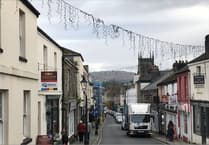THE Dartmoor Preservation Association celebrates the life of its first patron, the late Sylvia Sayer, in a factsheet published this week.
Entitled Sylvia Sayer, Shield of the Moor, the factsheet has been written by the DPA?s president, Kate Ashbrook, who knew Sylvia Sayer for more than 30 years until the famous conservationist died in early 2000.
?Sylvia Sayer, the champion of Dartmoor, was an example to us all. She fought for Dartmoor unremittingly for most of her 95 years. She didn?t care what people thought about her, so long as she did the right thing for Dartmoor. She battled calmly, courteously and effectively,? said Kate.
?She took part in numerous public inquiries to defend the moor, starting with one into military training in 1947. She appeared before parliamentary select committees and petitioned against parliamentary bills.?
Kate said the Swincombe and Meldon reservoirs, the Okehampton bypass, masts on the tops of tors, the Dartmoor Commons Bill, china clay inquiries, and tungsten mining and waste dumping on Crownhill Down were just a few of her battles.
?She saved High House Moor from afforestation, putting up the money to buy it before she knew it would be repaid by DPA members. She was instrumental in saving Shaugh Moor from china-clay waste dumping.
?Being outspoken, and being a woman, she made many enemies. In fact, she was exceptionally warm, kind and humorous with a large and close family ? a tribe of great grandchildren ? and a multitude of friends whom she welcomed to her house Cator, where there was always a roaring fire and a good tea.?
Kate said the best memorial for Sylvia would be a Dartmoor for ?ever rid of military training and china clay mining?.
She hated those who would destroy the moor or who put parochial interests first. Sylvia Sayer devoted more than half a century to defending Dartmoor ? becoming Lady Sayer in 1959 by virtue of her sailor husband?s knighthood.
The written celebration ? Sylvia Sayer: Shield of the moor (6 March 1904 ? 4 January 2000) ? commences with a poem by Sir Henry Slesser, former chairman of the Dartmoor National Park Committee.
Sylvia was born in Edwardian Plymouth, of an upright, middle-class family. Her great-grandfather owned Cattedown Wharf in old Plymouth harbour, her grandfather on her mother?s side, Robert Burnard, founded the Dartmoor Preservation Association in 1883. Her father was a naval surgeon who was at sea a great deal.
The joy of her childhood was the regular visits to Huccaby House on Dartmoor, which Robert Burnard leased from the Duchy of Cornwall.
There, Sylvia and her sister Phyllis found freedom and happiness, away from the starched rectitude of the Plymouth household. As she wrote in 1973:
?It was a place of strong and potent magic: no children were ever happier than we were there. To be told we were ?going to Huccaby? was to be seized with a kind of mad joy; to leave it was a cruel banishment . . . for me the Huccaby magic is still there and I can forget today?s packed cars and milling people around Huccaby Bridge, the car park in Huccaby Meadow and the litter floating in the Dart, and I?m back as a small grandchild staying at Huccaby House, with the lovely rushing voice of the river and the scent of the rhododendrons and pines blowing in at my bedroom window. And tomorrow would be bringing another wonderful Dartmoor day.?
Granite was in her blood (her mother?s forebears had farmed on Bodmin Moor), and when she and her husband, Guy, discovered Cator, a tumble-down longhouse near Widecombe, in 1928, they bought it for £150, lived there until the end of their lives, and exercised their common right to dig peat for the fire.
Shortly after the war Sylvia became deeply involved in the protection of Dartmoor. She played an important role in the establishment of the national park in 1951 and was a member of the park committee from 1952 to 1957 when she resigned in protest at the committee?s failure to uphold national values ? it was then a subcommittee of Devon County Council, under the thumb of a small group of aldermen.
Kate wrote that at that time Dartmoor faced a multitude of threats ??the expansion of military training and china clay mining, a TV mast on North Hessary Tor and ploughing and enclosure of open country to name a few. And the threats continued over the ensuing years.?
In 1951 she became chairman of the Dartmoor Preservation Association and built it up from only 140 members to the effective pressure-group that it is today. In 1973 she retired from the chair and became patron, jointly with Guy.
In the publication Kate recalls that Sylvia did not care what people thought about her, so long as she did the right thing for Dartmoor.
Kate wrote: ?She battled calmly, courteously and effectively, with steadfast support from Guy. Many were those who dreaded the beautifully written envelope dropping through their letter box: she never typed, but her immaculate handwriting was her hallmark.
Her pen was powerful, whether in an incisive letter to the press, or in evidence to a public inquiry where she was ruthless in her cross-examination and never caught out when questioned; her preparation was so thorough and her knowledge of the moor unparalleled.
She came from a middle-class family and took on the establishment in the days when it was not fashionable to do so.
In 1983, when Prince Charles as Duke of Cornwall invited her to Kensington Palace to celebrate the launch of the Duchy?s management plan for Dartmoor, she refused because the Prince showed no sign of telling the military to stop using Dartmoor for live firing.
l The Dartmoor Preservation Association has fought for the protection of Dartmoor since 1883, and currently has 2500 members. Pressure from the DPA led to Dartmoor being granted national park status in 1951.

.jpeg?width=209&height=140&crop=209:145,smart&quality=75)
-with-lightning).jpeg?width=209&height=140&crop=209:145,smart&quality=75)
